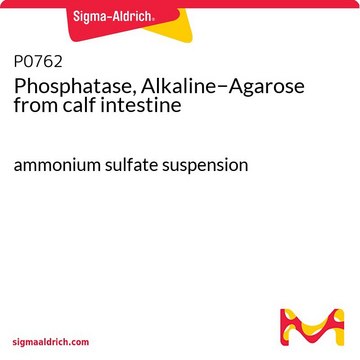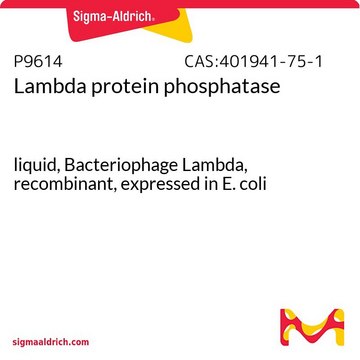P4978
Phosphatase, Alkaline from calf intestine
buffered aqueous glycerol solution
Synonyme(s) :
CIAP, CIP, Orthophosphoric-monoester phosphohydrolase (alkaline optimum)
About This Item
Produits recommandés
Qualité
for molecular biology
Forme
buffered aqueous glycerol solution
Poids mol.
~80 kDa
Concentration
≥10,000 units/mL
Numéro d'accès UniProt
Activité étrangère
DNase, RNase, none detected
Conditions d'expédition
wet ice
Température de stockage
−20°C
Informations sur le gène
cow ... ALPI(280993)
Vous recherchez des produits similaires ? Visite Guide de comparaison des produits
Description générale
Application
Composants
Définition de l'unité
Autres remarques
Inhibiteur
Produit(s) apparenté(s)
Substrat
Code de la classe de stockage
10 - Combustible liquids
Classe de danger pour l'eau (WGK)
WGK 1
Point d'éclair (°F)
Not applicable
Point d'éclair (°C)
Not applicable
Certificats d'analyse (COA)
Recherchez un Certificats d'analyse (COA) en saisissant le numéro de lot du produit. Les numéros de lot figurent sur l'étiquette du produit après les mots "Lot" ou "Batch".
Déjà en possession de ce produit ?
Retrouvez la documentation relative aux produits que vous avez récemment achetés dans la Bibliothèque de documents.
Les clients ont également consulté
Protocoles
CIP is used to remove 5’-phosphate groups from DNA, RNA and both ribo and deoxy-ribonucleoside triphosphates. Detailed protocol on how to dephosphorylate DNA.
Enzymatic Assay of Alkaline Phosphatase, Diethanolamine Assay (EC 3. 1. 3. 1)
Notre équipe de scientifiques dispose d'une expérience dans tous les secteurs de la recherche, notamment en sciences de la vie, science des matériaux, synthèse chimique, chromatographie, analyse et dans de nombreux autres domaines..
Contacter notre Service technique






